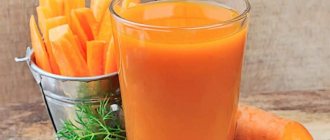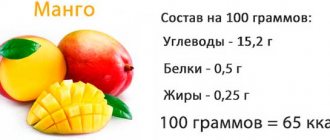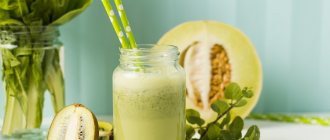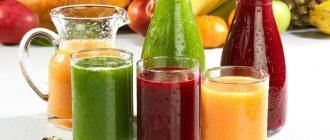For diseases of the gastrointestinal tract, including gastritis, a special diet is indicated. Nutrition should be moderate and balanced; some foods are strictly prohibited.
Some products are used as medicinal products. Among them, one of the first places is occupied by carrots - its consumption alleviates the symptoms of the disease. For gastrointestinal diseases, carrots are used raw and boiled; carrot juice is also consumed.
Is it possible to eat carrots with gastritis?
Carrots contain dozens of vitamins and microelements: vitamins A, B, C, iron, magnesium, fluorine, iodine, phosphorus, manganese. Its main advantage is its high beta-carotene content. The vegetable destroys the breeding ground for Helicobacter pylori bacteria, so its consumption is recommended for all forms of gastritis.
Attention! You are allowed to eat no more than 300 g of carrots per day.
How carrots work for different forms of gastritis
Gastritis is a complex disease, and with its different forms, the effect of carrots will also be different. The method of consuming the vegetable depends on the form of the disease.
With high acidity
The fresh product increases the concentration of acid, so it should not be taken by patients with gastritis with high acidity. In this case, boiled carrots will be useful. A heat-treated product is better absorbed by the body. It is prepared as an independent dish and added to other products. Freshly squeezed carrot juice is also contraindicated if you have high stomach acidity.
Advice. To preserve the healing properties of carrots while cooking, cook them in a saucepan with the lid closed.
For erosive
Erosive gastritis is manifested by inflammation of the gastric mucosa, in which small wounds (erosions) form on its surface.
With this form of the disease, the product is consumed only in boiled form. Carrot juice can be taken for preventive purposes when the stage of exacerbation of the disease has passed. The juice also serves as an excellent immune stimulant.
Useful properties of carrots for gastritis
In any form of the disease, carrots have a positive effect on the gastrointestinal tract:
- beta-carotene in the vegetable acts as a powerful antioxidant, it protects the walls of the stomach from the formation of ulcers;
- thanks to the antispasmodic effect, the vegetable reduces pain;
- destroys the breeding ground for bacteria in the stomach;
- has a mild laxative property, which helps cleanse the intestines;
- strengthens the walls of blood vessels;
- regulates metabolism in the body;
- enriches the body with vitamins.
Five reasons to eat carrots regularly
Remember how in childhood we were told: “Do you want to grow up? Eat carrots. Are your eyes hurting or your vision has deteriorated? Carrots will help. Problem skin? Don’t forget about vitamins—the orange root vegetable contains them.” It is worth noting that our parents were right, and carrots really help in solving these and many other problems. The vegetable has not just a large amount, but a rich composition. It contains the following vitamins, macro- and microelements, organic substances:
- Manganese, cobalt and fluorine.
- Copper, iodine, pectin.
- Vitamins from group B.
- Ash, fats, dietary fiber, proteins.
- Phosphorus, folic acid, iron.
- Molybdenum, zinc, sodium.
- Vitamins C, A, niacin.
The beneficial substances that are in the root vegetable can be listed for a long time. But you and I are interested in something else - what benefits do carrots bring to stomach gastritis? There are at least 5 reasons to make it your favorite vegetable and eat it regularly:
- Carrots take an active part in the process of restoring damaged mucosal cells.
- The root vegetable has an antispasmodic effect, so pain when consuming it is truly minimized.
- Freshly squeezed juice has a similar effect. It relieves irritation and provides the strongest protection for the gastric walls.
- Boiled carrots are especially necessary for gastritis. It regulates metabolism, which is a prerequisite for successful treatment of the disease.
- Recently, scientists have proven that the orange vegetable disinfects the environment in which Helicobacter pylori develops favorably.
How carrots affect acidity
Carrots and carrot juice are added to the diet for gastritis, taking into account the acidity of the stomach.
Increases or decreases
Fresh vegetables stimulate the production of acidic secretions, therefore, in case of high acidity, they are added to food only after heat treatment. During the remission stage, it is allowed to add fresh root vegetables and juice to the diet in small quantities.
For gastritis with low acidity, it is recommended to consume fresh carrots and freshly squeezed juice.
Important! Drink fresh carrot juice no later than 30 minutes after preparation, as it quickly loses its beneficial properties.
Carrot juice: how to prepare and use
It's good to drink a glass of carrot juice in the morning.
Freshly squeezed juice is very tasty. It can be prepared in a food processor/blender or juicer.
First you need to prepare the root vegetables: wash, cut off the thick end, peel if necessary. Then cut into medium-sized circles or cubes. Even the most powerful equipment can break down when chopping several whole root vegetables.
When cooking in a juicer, chopped carrots are placed in a special compartment and pressed with a pusher. You need to keep an eye on the containers in which the juice is collected. Vegetables can be juicy or dry, the amount of juice obtained depends on this. You may need to substitute another vessel or add more carrots.
When cooking in a food processor, the carrots are pureed. If the vegetable is not juicy enough, add a little water. Puree made in a blender will have a smoother consistency. Then boiled water is added to it, juice is obtained. The drink should be strained and mixed with orange juice if desired.
Attention! Freshly squeezed juice quickly oxidizes and loses its beneficial qualities, so it should be drunk immediately after preparation.
Beneficial properties of carrot juice:
- speeds up metabolism, removes toxins, improves digestion, and helps with bowel movements.
- increases immunity, reduces the risk of viral diseases;
- excellent source of energy;
- affects the amount of breast milk and its composition;
- increases fertility.
Carrot juice is used in folk medicine.
For children
Carrot juice can be given to children from 6 months, one teaspoon at a time. For older children, 100 g of juice, drunk in the morning on an empty stomach, helps get rid of worms, gently weakens the body, adds energy, and strengthens the immune system.
Features of eating carrots for gastritis
Despite the fact that patients with gastritis exclude many foods from the diet, the menu can be made tasty and healthy. Carrots will help with this.
Fresh
Before including a fresh vegetable in your diet, determine the acidity level.
With a reduced acidity level, carrots will help normalize the digestion process. It is grated or prepared into salads.
The product will be better absorbed by adding sour cream or olive oil.
Attention! It is not recommended to eat fresh carrots on an empty stomach.
Carrot salad with sour cream
It will take no more than 5 minutes to prepare the salad. For two carrots you will need 2 tbsp. l. sour cream, 2 tsp. sugar and a pinch of salt.
Wash the carrots, peel and grate on a fine or coarse grater. Add sugar and salt and stir. Add sour cream, stir again until smooth.
Carrot and parsley salad
Take 300 g carrots, 100 g parsley roots, 1 tsp. parsley, 50 g vegetable oil, pinch of salt, 1 tsp. Sahara. Grate carrots and parsley roots on a fine grater, add salt, sugar, butter. Mix.
Boiled
Boiled carrots can be eaten for any type of gastritis. Nutritionists say that after heat treatment, the vegetable is absorbed faster and better.
When cooked, the product does not affect the acidity level. It will be equally useful both as a separate dish and as an ingredient in salads, meat and fish dishes, and soups.
Carrot soup
We prepare the soup from:
- carrots – 400 g;
- onion – 1 pc.;
- cream – 100 ml;
- chicken broth – 500 ml;
- flour – 1 tsp;
- butter – 40 g;
- water – 1 l;
- salt – 1 tsp;
- greens to taste.
Cut the root vegetables into cubes, add salt and water and cook for 25 minutes. Chop the onion and lightly fry for 3-5 minutes in butter, add flour, stir. Drain the water from the pan with boiled carrots and beat the carrots in a blender until the consistency of puree. Add fried onions with flour, chicken broth and cook for 5-7 minutes. Add cream and herbs to the pan and cook over low heat for another 3 minutes.
carrot juice
Juice can only be consumed with low acidity. For patients with erosive gastritis and high acidity, the drink is contraindicated; a small amount of fresh juice is allowed during the period of remission. You can prepare two types of carrot juice - freshly squeezed (fresh) and canned (boiled).
Fresh
To get 1 liter of fresh juice, you will need 1.5-2 kg of carrots. Root vegetables must be washed, peeled, chopped and squeezed out the juice in a squeezer. If it turns out too thick, strain it from the cake through several layers of gauze or dilute it with water. You can add a little sour cream or vegetable oil to the drink to better absorb carotene.
Canned juice
For 1 kg of carrots you will need 50-100 g of sugar. Squeeze the juice through a juicer and let sit for 20 minutes to allow a sediment to form. Next, carefully drain the juice and strain through 2-3 layers of gauze. Pour the resulting juice into an enamel bowl and cook over medium heat.
Heat the juice to a temperature of 80-85°C, but do not bring to a boil. Then add sugar, stir and remove the container from the burner. The boiled juice should be immediately poured into dry jars almost to the brim, so that there is no more than 1 cm from the surface of the juice to the edge of the jar.
Place the jars in a pan filled with water so that it reaches the middle of the jars. Place the pan over medium heat, and after the water boils, sterilize for 30 minutes.
Seal the jars with lids and place them upside down under a warm blanket until they cool completely. With gastritis, the stomach does not absorb nutrients and vitamins well, so carrot drink is indispensable as a source of vitamin A, which is necessary for the restoration of the body.
Attention! Even during remission, use canned juice with caution. It is better to dilute it with boiled water in the ratio: 2 parts juice to 1 part water.
For an adult, the maximum drink per day is two glasses.
For gastritis, juice is taken 30 minutes before meals and the total amount is divided into several doses.
Rules of use
Carrots are eaten raw, boiled, stewed, made into juice, combined with other products - in each form they are tasty and healthy:
- Carrots contain carotene, when it enters the body it is converted into vitamin A. For better absorption, carrots are eaten with any butter or sour cream.
- It is recommended to chew raw carrots. Many children like this.
- Boiled vegetables are good to eat with meat: digestion is easier and iron is better absorbed.
- Boiled carrots have 14% more vitamin A than raw carrots.
- When cooking vegetables, cover the dish with a lid. This reduces the loss of nutrients, preserves aroma and taste.
How to give carrots to children
Carrots are given to children from 6 months
The large amount of vitamin A contained in carrots is necessary to maintain good vision, so this vegetable should be on the menu of every pregnant woman. It helps the fetal visual organs to form correctly and strengthens teeth and bones.
Carrots can be given to a baby from six months of age. If the child is prone to allergies, the introduction of the product should be delayed until 7–8 months.
Attention! Any product should be introduced into your baby's complementary foods gradually to make sure there is no allergic reaction or intolerance.
Harm and contraindications
In some cases, carrots can harm the body.
Excessive consumption of this vegetable causes nausea, fatigue, headaches, and changes in skin color. Excess beta-carotene disrupts liver function.
Many people report heartburn and stomach discomfort after eating carrots on an empty stomach.
In what cases is it strictly forbidden to eat carrots?
Carrots are contraindicated for a number of diseases:
- stomach ulcer in the acute stage;
- acute pancreatitis;
- acute gastritis with high acidity;
- liver diseases;
- inflammatory bowel diseases;
- allergic reactions.
Products recommended for consumption
Allowed products for stomach ulcers are selected taking into account the patient’s condition and stage - exacerbation or remission. Usually the diet is compiled taking into account treatment table No. 1 according to Pevzner. It is aimed at moderating chemical, mechanical and thermal effects on the gastrointestinal tract. That is why foods that strongly stimulate secretion (secretion of gastric juice), irritate the mucous membrane, and are difficult and take a long time to digest are excluded. Allowed foods include:
- dried wheat bread made from premium flour, white crackers, dry biscuit, savory cookies;
- fresh non-acidic cottage cheese and kefir, yogurt. Curd dishes are allowed: baked cheesecakes, lazy dumplings, puddings;
- soups in a weak vegetable broth with pureed or well-cooked cereals, pureed vegetable soups (except cabbage), milk soups with noodles;
- lean meat (beef, rabbit, turkey and chicken), steamed cutlets, boiled tongue and liver;
- lean fish without skin, boiled or steamed;
- some cereals: semolina, buckwheat, oatmeal, rice;
- some vegetables: potatoes, beets, cauliflower;
- sweet varieties of fruits and berries, available in the form of jelly, mousse and jellies;
- drinks: diluted tea (with milk or water), diluted non-acidic juices, rosehip decoction.
Such a diet can help reduce inflammation and normalize the secretory and motor functions of the stomach. As an additional source of nutrients and energy, as well as to activate reparative processes in the mucous membrane, special mixtures are prescribed - for example, Nutrien® Standard. It is rich in macro and micronutrients, has a balanced composition, is easily digestible and does not burden the gastrointestinal tract.
A therapeutic diet for peptic ulcer disease is not just an excellent addition to the treatment complex, it is also part of the treatment of the disease, as well as a source of energy for the body during the period of treatment and recovery. The diet is quite varied, so sticking to such a diet is quite simple.
(0 ratings; article rating 0)











